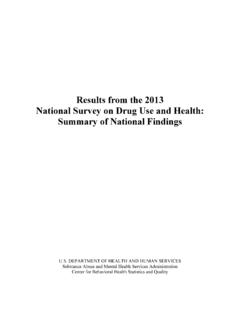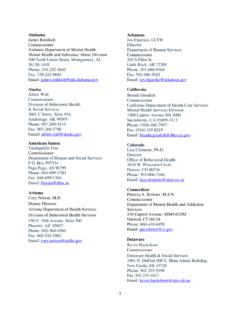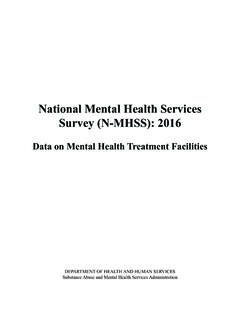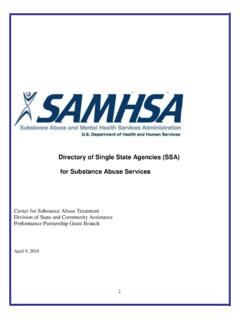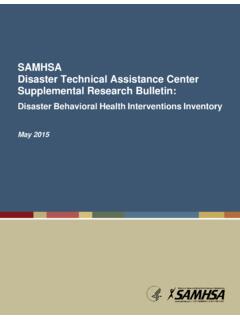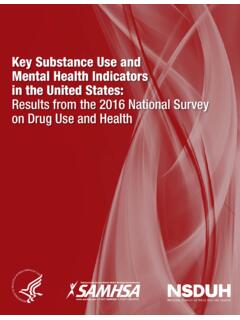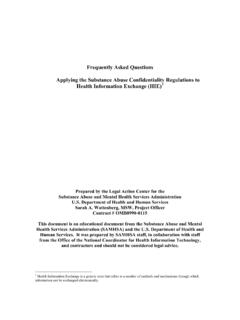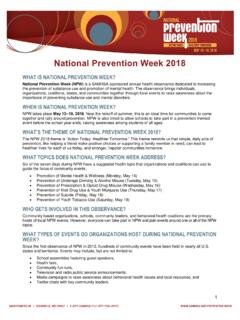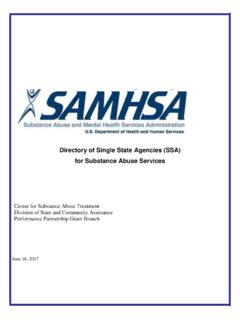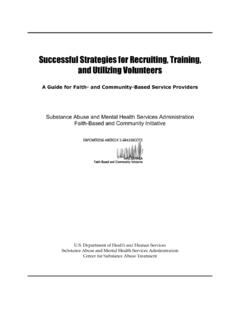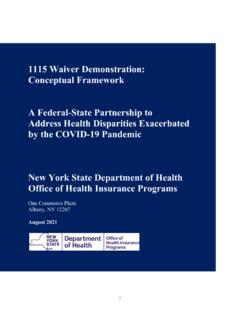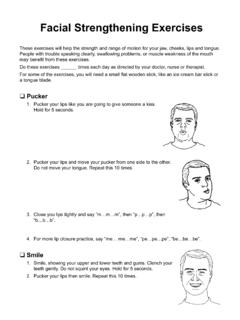Transcription of 988 APPROPRIATIONS REPORT
1 988 APPROPRIATIONS REPORT December 2021 988 APPROPRIATIONS REPORT CONTENTS 1 1. Introduction and 2 2. Updated data on suicide rates and 4 3. Lifeline call/text volume data .. 6 4. 988 Lifeline funding needs .. 9 5. Assessment of whether other services would improve services of the 13 6. Training to improve service for at-risk youth .. 13 7. Conclusion .. 15 Appendix A: 988 Volume 16 References .. 20 i 988 APPROPRIATIONS REPORT INTRODUCTION As directed by Congress from the enacted budget for Fiscal Year (FY) 2021, the Substance Abuse and Mental health Services Administration (SAMHSA) is responding to congressional questions regarding the National Suicide Prevention Lifeline (Lifeline). The following REPORT language was included in the FY 2021 Labor- health and Human Services APPROPRIATIONS Bill: The agreement includes an increase and requests that SAMHSA provide a REPORT to the Committees on APPROPRIATIONS of the House of Representatives and the Senate within 180 days after enactment of this Act on the level of funding required to meet the needs of the Lifeline, and includes updated data on suicide rates and attempts.
2 In addition, SAMHSA is directed to provide a REPORT to the Committees on APPROPRIATIONS of the House of Representatives and the Senate and post such REPORT on SAMHSA s website within 180 days of enactment of this Act detailing call and text volume over the past three years as applicable. The REPORT shall also include an assessment of whether other services such as emails, videos, or other digital modes of communications would improve service of the Lifeline. As SAMHSA considers expanding this service, the agreement encourages SAMHSA to leverage existing infrastructure to the extent practicable. The agreement further urges SAMHSA to provide specific training programs for counselors to increase competency in serving at-risk youth through the utilization of existing specialized resources. The creation of 988 is a once-in-a-lifetime opportunity to strengthen and expand the Lifeline and transform America s behavioral health crisis care system to one that saves lives by serving anyone, at any time, from anywhere across the nation.
3 Preparing the Lifeline for full 988 operational readiness will require a bold vision for a system that provides direct, life-saving services to all in need and links them to community-based providers uniquely positioned to deliver a full range of crisis care services. SAMHSA sees 988 as the linchpin and catalyst for a transformed behavioral health crisis system in much the same way that, over time, 911 spurred the growth of emergency medical services in the United States. Over time, the system that SAMHSA envisions will aim to: Provide enhanced access for people in behavioral health crisis through the use of an easily remembered three-digit number; Reduce reliance on the police by linking Lifeline/988 centers with mobile crisis teams (when the person in crisis requires services beyond what the call center itself provides); Reduce the deadly gaps in the existing fragmented behavioral health crisis care system by enabling Lifeline/988 centers to stay in contact and follow up with those in crisis; Relieve emergency room boarding by providing needed evaluation and crisis intervention in the community whenever possible; and Better meet the behavioral health needs of all people experiencing crises in a way that reduces stigma and encourages people at risk and their family members to seek help in the future.
4 This REPORT addresses the congressional requests above in the following seven sections: Section 1: Introduction and context Section 2: Updated data on suicide rates and attempts Section 3: Lifeline call/text volume data Section 4: 988 Lifeline funding needs Section 5: Assessment of whether other services would improve services of the Lifeline Section 6: Training to improve service for at-risk youth Section 7: Conclusion 1 988 APPROPRIATIONS REPORT 1. INTRODUCTION AND CONTEXT Overview of Lifeline Program In 2019, the Federal Communications Commission (FCC) proposed 988 as the three-digit number for suicide prevention and mental health crises. The following year, the National Hotline Designation Act (Public Law 116-172) was signed into law, incorporating 988 as the new Lifeline and Veterans Crisis Line number.
5 This new number will become available using any cell phone, land line, or voice-over internet device by July 16, 2022. The new three-digit hotline (988) builds directly on the original Lifeline that was established in 2005. The Lifeline is currently accessible through the toll- free number 1-800-273-TALK and operates 24 hours per day, 7 days per week. The Lifeline program contains three primary elements: A network of over 180 independently operated and funded local call centers, including 38 chat/text centers and three Spanish language centers; Nine national backup centers; and A single national system administrator. Local call centers are located throughout the country and often are part of behavioral health organizations or other health systems. The current system administrator is Vibrant Emotional health (Vibrant), which oversees the Lifeline program through a cooperative agreement, a closely coordinated grant support mechanism, administered by SAMHSA.
6 In this role, SAMHSA provides assistance, oversight, and performance monitoring through operations meetings and data review. The system administrator guides and bridges the network of independent centers, onboards centers into the network, sets training and performance standards, provides technology infrastructure, and collects data on center performance. Most of these centers receive minimal direct Federal funding to support their operations (typically a yearly stipend of $2,500 $5,000), relying instead on local, state, and private funding, as well as the significant utilization of volunteers. This funding mix varies considerably across local centers, with no consistent pattern of investments across states and localities. Process of Lifeline Response to People in Crisis When an individual is experiencing a mental health crisis and calls the Lifeline, the caller is routed to the nearest local crisis center (based on area code). If local crisis centers are unable to answer incoming calls from individuals in distress, the Lifeline utilizes a subnetwork of contracted national backup centers to ensure capacity can meet the demand.
7 There are also centers that receive Federal funding specifically to respond to text and chats, as most local centers do not currently have the capacity to address text and chat. Within the 38 chat/text centers, 19 core centers receive $250,000 per year each in Federal support to maintain dedicated chat/text response, with further adjustments for increased volume. The other 19 chat/text centers respond only on an ad hoc basis and receive a limited Federal stipend of $2,500 $5,000 to answer chats and texts. Despite the backup system and designation of specialized chat and text centers, current Lifeline capacity is only sufficient to address approximately 85 percent of calls, 56 percent of texts, and 30 percent of chats (analysis as of December 2020). 988 Implementation Considerations SAMHSA has identified two overarching goals that must inform 988 s launch and future operations: Strengthen and expand the safety net capabilities of the Lifeline, providing life-saving service to all who contact 988; and Transform our country s behavioral health crisis care system , so that services are available to anyone, anywhere, anytime.
8 SAMHSA s near-term priority is to ensure all Americans have access to a suicide Lifeline that can provide timely, high-quality crisis response. This will include several primary areas of focus, including enhancing Lifeline network operations, strengthening local crisis call center capacity, improving messaging and public awareness, and expanding federal support through the formation of a 988 & Behavioral health Crisis Coordination Office. 2 988 APPROPRIATIONS REPORT A primary consideration for implementing 988 is having a sufficient number of paid staff at the local centers to address the contact volume. This is particularly an issue with respect to chat response, where encounters typically take longer and involve higher levels of clinical acuity. In addition, ongoing data infrastructure upgrades are necessary to expand access and provide a consistent user experience.
9 Examples of upgrades include more efficient routing technologies and data collection to track response times, as well as more consistent demographic data collection to identify population needs and any disproportionality in service delivery and outcomes. Delivering on the second goal which involves transforming our nation s broader behavioral health crisis care system will require longer-term structural changes and investments. These include strengthening core behavioral health crisis care services, ensuring rapid post-crisis access, enabling advanced data integration, enhancing the behavioral health crisis care workforce, and establishing sustainable sources of funding for the broader crisis system . Beyond the current Lifeline functionality, it is critical that individuals experiencing a behavioral health emergency have access to a coordinated crisis system of care. Effectively responding to people in crisis who are experiencing a behavioral health emergency has three main components as outlined in SAMHSA s National Guidelines for Behavioral health Crisis Care: providing someone to talk to, providing in-person response, and providing a place to go.
10 Implementing 988 successfully will be a critical first step in evolving the broader crisis continuum. Current research suggests that many crises can be effectively addressed through a call alone. In addition, call centers that have follow-along capacity and/or access to local outpatient treatment resources can provide enhanced crisis care. A robust crisis system , including 988 access through the Lifeline network, will decrease suicides, reduce arrests and criminal justice involvement for individuals with behavioral health needs, and will facilitate linkages to care that reduce unnecessary emergency department boarding and hospitalization. As one example, the crisis system in Tucson, Arizona which covers the southern Arizona service are highlights the potential effectiveness of a robust crisis system . A FY2019 analysis provided by Arizona Complete health revealed that 80 percent of crisis line calls were resolved without dispatching mobile crisis teams, law enforcement, or emergency medical services.
